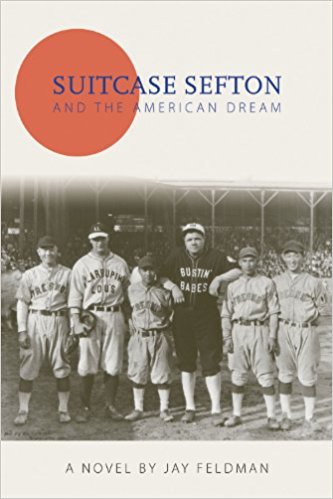Suitcase Sefton and the American Dream (book)
Creators: Jay Feldman
Novel by Jay Feldman about a New York Yankees scout who discovers a hot Nisei pitching prospect in an American concentration camp during World War II.
Protagonist Mac "Suitcase" Sefton is a scout for the New York Yankees in the early days of World War II. A former player, he had been on the brink of being called up to the major leagues when a farming accident in his Oklahoma hometown resulted in his losing a leg. Offered a job as a scout by a former teammate, he's spent the last decade on the road searching out prospects. While chasing after a prospect in Arizona, he stumbles onto an unspecified Japanese American concentration camp, where he spots a pitcher with big league potential. Finagling his way into the camp, he is shocked when the pitcher, a Nisei named Jerry Yamada, doesn't seem interested in signing with the Yankees. But as he gets to know Yamada, his family, and his teammates, Sefton begins to understand Jerry's reasons, and, unexpectedly, finds a feeling of community—and even love—among the incarcerated Japanese Americans that had been lacking in his itinerant life.
Author Jay Feldman (1943– ) has written extensively on baseball history for Sports Illustrated and other publications. Suitcase Sefton , his first novel, was inspired in part by an earlier article he did on Japanese American baseball in the concentration camps for Whole Earth Review titled "Baseball Behind Barbed Wire" in 1990, A native of Brooklyn, Feldman also wrote a musical play on the life of "Mad Bomber" George Metesky set in the 1930s to 1950s that was produced in 2012. Among his prior non-fiction books are Hitting: An Official Major League Baseball Book (an instructional book, 1991), When the Mississippi Ran Backwards: Empire, Intrigue, Murder, and the New Madrid Earthquakes (2005) and Manufacturing Hysteria: A History of Scapegoating, Surveillance, and Secrecy in Modern America (2011).
Suitcase Sefton contains a number of errors or implausibilities in its portrayal of the concentration camps. As is the case with many fictional depictions of life in the camps, conditions are made worse then they really were. Armed soldiers are described as patrolling the camp (pages 19, 98–99), and one clubs an inmate over the head during a protest over food (25–26). But outside of martial law situations at Manzanar and Tule Lake , soldiers were limited to guarding the perimeters of War Relocation Authority administered camps and did not venture inside the gates. Two characters are put in the stockade for stealing fence posts (161); however only post-segregation Tule Lake had a stockade. Another character, in recalling life in a prior " assembly center ," claimed that they "had to wash in horse troughs" (97). The timing of some depicted events are also off. The director of the Arizona camp tells Sefton that they "didn't start getting the camp ready until just after Pearl Harbor" (92); in reality, the sites for the WRA camps weren't even selected until several months later and work on them didn't commence until the spring of 1942. Later, those who answered "no-no" on the loyalty questionnaire are depicted as being transferred to Tule Lake immediately afterwards (201–03); it actually the took the WRA several weeks to figure out what to do with the "no-nos," and the transfer to Tule Lake didn't begin place until the late summer of 1943. A character also claims that "all Japanese-Americans in California, Oregon, and Washington were sent away" (98); however, Japanese Americans in the eastern halves of Oregon and Washington were allowed to remain in place.
Might also like: Heart Mountain by Gretel Ehrlich; Bridge of Scarlet Leaves by Kristina McMorris; What the Scarecrow Said by Stuart David Ikeda
| Author | Jay Feldman |
|---|---|
| Pages | 240 |
| Publication Date | 2006 |
For More Information
Publisher's website: http://www.triumphbooks.com/suitcase-sefton-and-the-american-dream-products-9781572438125.php .
Author website: http://www.jfeldman.com/suitcase.html .
